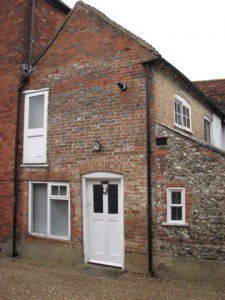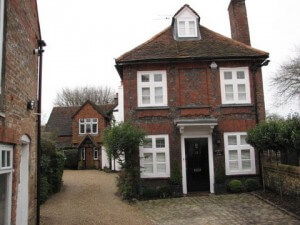 Norwood’s Court used to be known as Norwood’s Yard. It took its name from Richard Norwood, who set up a currier’s business here in the 1740s. A currier is a specialist in the leather processing industry. After the tanning process, the currier applies techniques of dressing, finishing and colouring to the tanned hide to make it strong, flexible and waterproof. The leather is stretched and burnished to produce a uniform thickness and suppleness, and dyeing and other chemical finishes give the leather its desired colour. After currying, the leather is then ready to pass to the fashioning trades such as saddlery, bridlery, shoemaking and glovemaking. See the attached pdf for details about the Norwood, Harding, Bovingdon and Ball families.
Norwood’s Court used to be known as Norwood’s Yard. It took its name from Richard Norwood, who set up a currier’s business here in the 1740s. A currier is a specialist in the leather processing industry. After the tanning process, the currier applies techniques of dressing, finishing and colouring to the tanned hide to make it strong, flexible and waterproof. The leather is stretched and burnished to produce a uniform thickness and suppleness, and dyeing and other chemical finishes give the leather its desired colour. After currying, the leather is then ready to pass to the fashioning trades such as saddlery, bridlery, shoemaking and glovemaking. See the attached pdf for details about the Norwood, Harding, Bovingdon and Ball families.
All the houses below are listed grade II.
No.1 is the rear part of no. 34, The Broadway. It was built in the 18th century in chequer brick, partly colour-washed. It has an old tiled roof.
No. 3 was built in the 17th century with a timber frame later in-filled with brick.
No 6 was built in the 17th century and re-faced in the 19th with red and grey brick.
No. 12 is late 17th century red and grey brick, with red brick dressings and quoins (at the corner of the walls). It adjoins no. 6 at the back. It has two cross mullioned and transomed windows and a central recess to first floor having diaper pattern brickwork, all with flat arches and scalloped aprons. There is a central panel door with a hood on fluted brackets and a frieze over the door.
Norwoods Cottage was built in the 17th century, refaced in the 18th and altered and extended in the 20th.
Well House is a 17th century timber framed building, refaced in the 18th century. It is attached to rear of no. 36, The Broadway.
Click on any of the photographs below to enlarge it and to see the description. Then click on forward or back arrows at the foot of each photograph. To close the pictures, just click on one.






